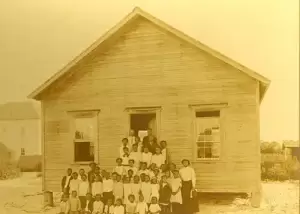Teaching and Preaching: All-Black Schools
The earliest schools for African Americans in Palm Beach County resulted from petitioning of the Dade County Board of Public Instruction by the black communities of various settlements. As was sometimes done with white schools, the residents often provided the land or building. The first school for blacks opened in 1894, when trustees of the Tabernacle Baptist Church on Clematis Street offered the use of their building. Due to overcrowding, the initial 74 students were divided into two groups that each attended school for four months. In 1897 the school was renamed Colored School No. 1 and moved into a schoolhouse built at Datura Street and Tamarind Avenue. The name changed again to Lake Academy in 1900, when it was expanded to grades 1-10; it was also referred to as the Clear Lake School.

A second school for blacks opened in West Palm Beach, although it was named Colored School No. 3, Palm Beach; it was closed in 1905. The students were transported by wagon to School No. 1, which soon received another new name, West Palm Beach Colored School. Also in West Palm Beach, Colored School No. 8 opened on Easy Street (now 22nd Street) in the Pleasant City community in 1906.
When the black citizens of Linton (which would become Delray in 1901) petitioned for a school and teacher in 1894, officials required the community to supply the building, and to maintain the canal in a clean condition for the teacher’s travel. Colored School No. 4 opened in a thatched hut on the east side of NW 5th Avenue, south of NW 1st Street. By 1907 the hut had been replaced by a one-room wood structure. It would later become Spady Elementary and Carver High Schools.
The Boynton Colored School opened in 1896, renamed Boynton Negro Elementary in 1909, and Poinciana Elementary since 1953, on Green Street, now called North Seacrest Boulevard.
In 1905 William J. and Annie Roundtree, residents of the predominantly black Limestone Creek community of West Jupiter, donated one acre of land off Limestone Creek Road, where Colored School No. 35 opened two years later.
Although the school board postponed a petition for a black school in Loxahatchee as early as 1902, Colored School No. 7, Loxahatchee, opened in a church in 1906.
In most cases, the black schools had terms as short as four months, so the children could also do farm work. This limitation did not get easier for many years, as the black community supplied labor for white farmers whose businesses demanded more effort as they grew.

